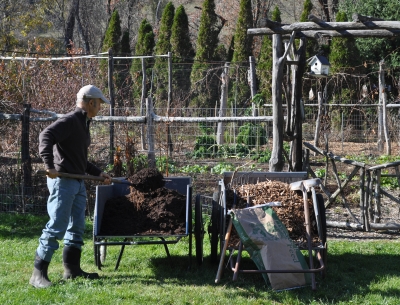GOURMET FERTILIZER
Vegetarian Plants
The other day in the hardware store I overheard someone ask the clerk for some rose food. My eyebrows went up as I thought to m’self, “Are they kidding, thinking that roses need their own special food? Next, I’ll hear about plants that prefer vegetarian or kosher food, perhaps fish emulsion on Fridays?”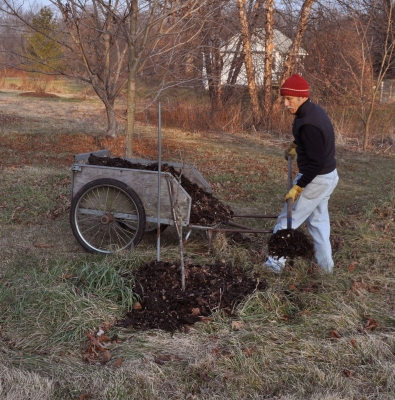
All this food science when it comes to plants may boost fertilizer sales, but it hardly bothers plants either way. Plants take up the bulk of their nutrients as ions (charged atoms or groups of atoms) that are dissolved in water in the soil. Rock particles, as well as humus and organic fertilizers, decompose to release nutrient ions slowly into the soil solution. Chemical fertilizers are already in ionic form, so when you sprinkle a handful on the soil, they dissolve as soon as they contact water.
A Well-Rounded, Wholesome Diet
What’s so special about rose food for roses? Nothing. All plants need healthy doses of nitrogen, phosphorus, and potassium, and lesser amounts of other nutrient elements. But unless a soil is an infertile sand where neither crop rotation nor some weed growth is allowed to balance soil nutrients, specific foods don’t usually have to be tailored for specific plants.
My garden grows pretty well, and I feed all my plants the same diet: An annually replenished mulch of wood chips, leaves, or compost, and, if extra nitrogen is needed, an annual sprinkling of soybean meal. Theoretically and in practice, an inch depth of compost alone provides sufficient nourishment for the plants. 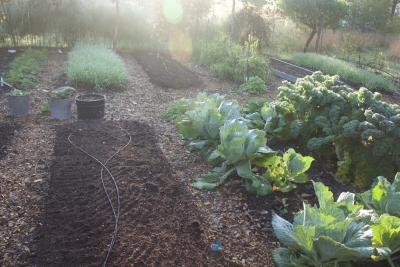 That inch depth of compost is the only thing my vegetable beds get each year, and it nourishes closely planted cabbages, tomatoes, lettuces, and other plants from the first breath of spring until cold weather barrels in to shut down production.
That inch depth of compost is the only thing my vegetable beds get each year, and it nourishes closely planted cabbages, tomatoes, lettuces, and other plants from the first breath of spring until cold weather barrels in to shut down production.
Garden plants that are pressed into sustained production (nonstop flowering of those rose bushes, for example) or vegetables best plumped up with extra-succulence, like some leafy vegetables, might need an extra push with additional nitrogen. Or not.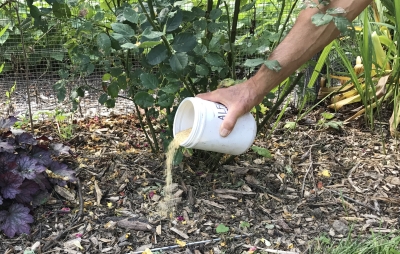
Soybean meal, available in garden centers as well as anywhere selling animal feeds, is insurance in the form of a high nitrogen, organic fertilizer. Cottonseed meal, hoof and horn meal, alfalfa meal, or blood meal would serve as well. Soil microorganisms decompose the proteins in any of these fertilizers in a series of steps to produce amino acids, then ammonium ions, then nitrate ions. The latter two ions are the forms of nitrogen most utilized by plants.
I grew Brussels sprouts unsuccessfully for many years, with sprouts hardly bigger than marbles lining up along the spindly stalks. So last year, I sprinkled some soybean meal (2 pounds per hundred square feet) on the ground before laying down the compost. Success! The plants grew into sturdy, five-foot-high stalks along which were lined up almost golfball-sized sprouts.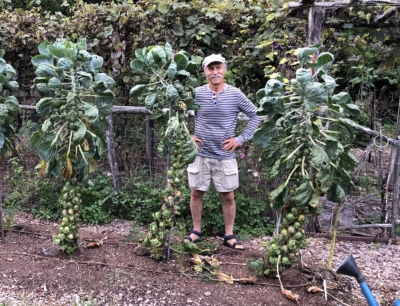
Flowers and mature trees and bushes get nothing more than arborists’ wood chips, leaves, hay, straw, or wood shavings here. Even these low nitrogen mulches eventually release nitrogen as their lower layers break down in the soil.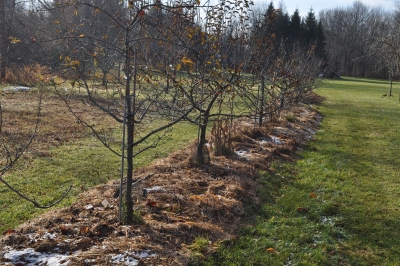
But Still . . .
You might point out that, still, there are some plants that need a specialty plant food: “acid plant food” for azaleas and rhododendrons, for example. You’ve got a point; these plants do have special needs. But my universal pabulum of mulch and soybean meal also suffices for them.
The special requirement of these plants is an acid soil. If a soil is not naturally acidic, the soil doesn’t need an “acid plant food,” it needs to be made acidic. The way to make a soil acidic is with sulfur, a naturally mined mineral. The amount needed depends on the existing soil acidity (determined with a quick soil test), the desired soil acidity (a pH of about 5 for acid-loving plants), and whether the soil is sandy or clayey. A sandy soil needs about 3⁄4# per 100 sq. ft. for each pH unit change; clay soils need about two-and-a-half times that amount. The sulfur to use is “pelletized” because it’s less dusty to work with. And, obviously, any compost for these plants should have had no added limestone.
What about the special nitrogen requirement of these plants? Commercial “acid plant food” supplies acid-loving plants with their preferred form of nitrogen, which is ammonium ion. Let’s see what happens to my soybean meal in an acid soil. A few paragraphs earlier, I wrote that though an orchestrated series of steps, various soil microorganisms gobble up proteins in soybean meal or other organic fertilizers, breaking them down to amino acids, ammonium ions, and then nitrate ions. In acidic soils, microorganisms that do that last job are absent. Breakdown stops at ammonium ion — just what those plants like best.
Plants don’t need haut cuisine, just plain, wholesome food. (More details about this in Weedless Gardening and The Ever Curious Gardener.)